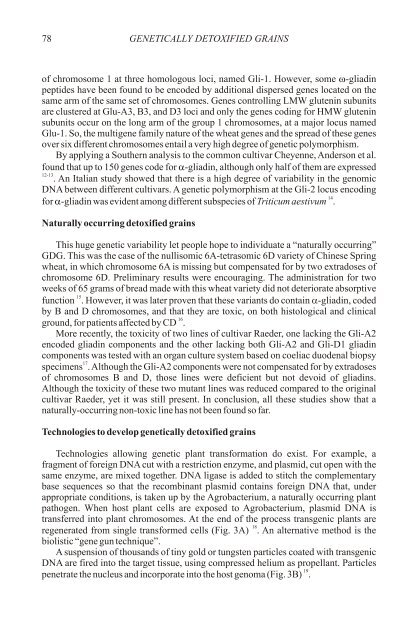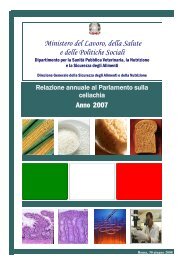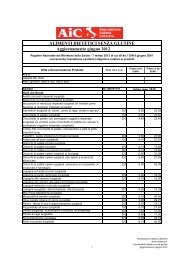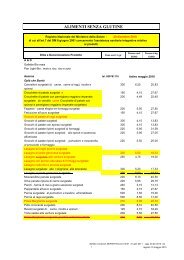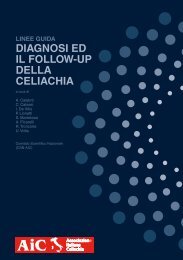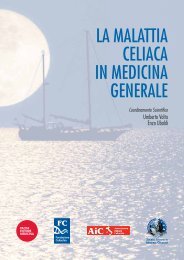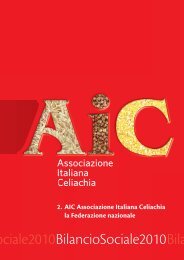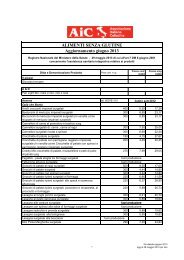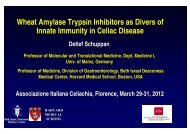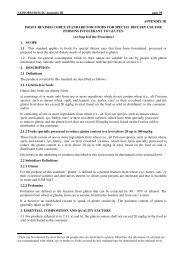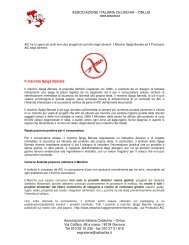primary prevention of coeliac disease - Associazione Italiana ...
primary prevention of coeliac disease - Associazione Italiana ...
primary prevention of coeliac disease - Associazione Italiana ...
You also want an ePaper? Increase the reach of your titles
YUMPU automatically turns print PDFs into web optimized ePapers that Google loves.
78 GENETICALLY DETOXIFIED GRAINS<br />
<strong>of</strong> chromosome 1 at three homologous loci, named Gli-1. However, some w-gliadin<br />
peptides have been found to be encoded by additional dispersed genes located on the<br />
same arm <strong>of</strong> the same set <strong>of</strong> chromosomes. Genes controlling LMW glutenin subunits<br />
are clustered at Glu-A3, B3, and D3 loci and only the genes coding for HMW glutenin<br />
subunits occur on the long arm <strong>of</strong> the group 1 chromosomes, at a major locus named<br />
Glu-1. So, the multigene family nature <strong>of</strong> the wheat genes and the spread <strong>of</strong> these genes<br />
over six different chromosomes entail a very high degree <strong>of</strong> genetic polymorphism.<br />
By applying a Southern analysis to the common cultivar Cheyenne, Anderson et al.<br />
found that up to 150 genes code for a-gliadin, although only half <strong>of</strong> them are expressed<br />
12-13<br />
. An Italian study showed that there is a high degree <strong>of</strong> variability in the genomic<br />
DNA between different cultivars. A genetic polymorphism at the Gli-2 locus encoding<br />
14<br />
for a-gliadin was evident among different subspecies <strong>of</strong> Triticum aestivum .<br />
Naturally occurring detoxified grains<br />
This huge genetic variability let people hope to individuate a “naturally occurring”<br />
GDG. This was the case <strong>of</strong> the nullisomic 6A-tetrasomic 6D variety <strong>of</strong> Chinese Spring<br />
wheat, in which chromosome 6A is missing but compensated for by two extradoses <strong>of</strong><br />
chromosome 6D. Preliminary results were encouraging. The administration for two<br />
weeks <strong>of</strong> 65 grams <strong>of</strong> bread made with this wheat variety did not deteriorate absorptive<br />
15<br />
function . However, it was later proven that these variants do contain a-gliadin, coded<br />
by B and D chromosomes, and that they are toxic, on both histological and clinical<br />
16<br />
ground, for patients affected by CD .<br />
More recently, the toxicity <strong>of</strong> two lines <strong>of</strong> cultivar Raeder, one lacking the Gli-A2<br />
encoded gliadin components and the other lacking both Gli-A2 and Gli-D1 gliadin<br />
components was tested with an organ culture system based on <strong>coeliac</strong> duodenal biopsy<br />
17<br />
specimens . Although the Gli-A2 components were not compensated for by extradoses<br />
<strong>of</strong> chromosomes B and D, those lines were deficient but not devoid <strong>of</strong> gliadins.<br />
Although the toxicity <strong>of</strong> these two mutant lines was reduced compared to the original<br />
cultivar Raeder, yet it was still present. In conclusion, all these studies show that a<br />
naturally-occurring non-toxic line has not been found so far.<br />
Technologies to develop genetically detoxified grains<br />
Technologies allowing genetic plant transformation do exist. For example, a<br />
fragment <strong>of</strong> foreign DNA cut with a restriction enzyme, and plasmid, cut open with the<br />
same enzyme, are mixed together. DNA ligase is added to stitch the complementary<br />
base sequences so that the recombinant plasmid contains foreign DNA that, under<br />
appropriate conditions, is taken up by the Agrobacterium, a naturally occurring plant<br />
pathogen. When host plant cells are exposed to Agrobacterium, plasmid DNA is<br />
transferred into plant chromosomes. At the end <strong>of</strong> the process transgenic plants are<br />
18<br />
regenerated from single transformed cells (Fig. 3A) . An alternative method is the<br />
biolistic “gene gun technique”.<br />
A suspension <strong>of</strong> thousands <strong>of</strong> tiny gold or tungsten particles coated with transgenic<br />
DNA are fired into the target tissue, using compressed helium as propellant. Particles<br />
19<br />
penetrate the nucleus and incorporate into the host genoma (Fig. 3B) .


